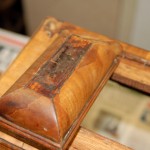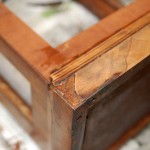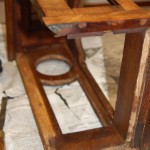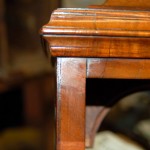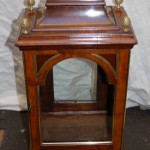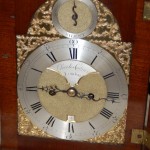From the very onset of our business we have always had our own highly skilled staff employed in Cheshire. They undertake skilled antique clock and furniture repairs for our London shop. Antique clock repair is something that can only be carried out by highly qualified and time-served skilled staff. It is important to know what they are doing. In my latest blog I will be looking at the restoration of a badly damaged antique clock cabinet. This clock was damaged by a very hungry owners dog ! You can see from the pictures below, taken prior to restoration, the damage to the base and trunk door areas on the clock.
One very hungry pet dog

As you will notice damage was to the sides of the base and the bottom of the door in the main. This is very intricate antique clock restoration. Our skilled cabinet restorer carefully restored this clock to its former glory. Whilst the restoration of the antique clock was ongoing. We noticed the two sides of the base banding had been replaced with mahogany veneers over the years. We took this away and replaced the mahogany with the banding to match the trunk door. This being tulip wood.
Furniture Repairs
As you will see from the finished restored pictures. Close up pictures of the damage from the clock, the skills of a craftsman. All repairs were carried out in hand cut veneers of wood. This was a like for like match. Animal glues were used like in the original. After all the antique clock repairs were carried out at our base here in Cheshire. The clock was redelivered back to very happy owners.
Repairs Done Sympathetically
Restoring antique clocks like we have done for over 40 years here at Pendulum of Mayfair or Coppelia Antiques is vital to be done properly. Do not have a clock that has been poorly restored. This would take away from the value of the clock. Restoring your antique clock sympathetically can add thousands of pounds to the value. If the clock is genuine and basically all there. Spending £3,000 or so to restore your clock can be money in the bank.
Don’t cut costs in repairs
Spending £1500 for restoring your clock badly you may think you are saving money but do not be misled. Poor restoration can actually reduce the value of the clock, your £1,500 may well be lost. We charge out at competitive rates for unrivalled quality workmanship I believe. For a quote please send pictures of the item needed to be restored to the contact at the bottom of this piece.
Seldom seen damage
Can I point out before I go on, damage due to canines I have only ever encountered twice in all my time. I believe this was done by overexcited puppy’s with teething issues, you need not worry to much ! Basically antique clock cabinet repairs are much more standard. Loose moulding, little pieces of veneer lost, or he odd scratch here or there. Sometimes years of dirt to the surface of the case just needs carefully taking back and then the true colour of the cabinet can be achieved.
Colour of piece
The colour of every clock tends to be different and dependant on the wood and how this had reacted with the sunlight over the years. Hopefully if you choose a restorer he will preserve the colour and not just splash the stain of the day all over your clock. To many times I have seen furniture restorer throw shellac french polish to high gloss standards. Then stain whatever colour they were using that day on items. Rather than building up the finish underneath the years of grime, and basically wax finishing.
Wax finish is vital
Soft finish of wax, rather than the ploughed field of a poorly french polished and stripped surface is required. The grain on any antique clock takes years to fill with many years waxing. You do not want an open grain sticky finish, like what you will see on lots of modern furniture today.
Conclusion
I hope the three pictures included and the pictures of the clock now restored show what can be done by sympathetic highly skilled craftsman. We have undertaken repairs for Museums , a very important Embassy , and lots of major hotels in central London. We also undertake repairs for the general public. We have highly skilled staff specifically now just undertaking outside repairs.
Antique furniture and clock repair
It is a growing side of our business. Put your family heirlooms in safe hands and contact the specialist today. All public enquiries for antique clock repairs for a limited time will receive our special offer trade daily rate. You will need to quote ” antique clocks blog special offer” on your e.mail. Please hurry this is for a limited time only and applies to cabinet work.
We also have two full time horologists on staff to repair your antique clock movements. These are also highly skilled professionals. I suggest you should have a major overhaul of your clock every 40 years. If you have had this carried out properly a clean every 10 years or so. This will keep wear on any pivots etc to a minimum.
I hope you will agree the finish restored antique clock below looks stunning. The total time was approx 10 working days to restore movement and cabinet.
Any questions to
Daniel Clements
Manager: Pendulum of Mayfair- London -0207 629 6606/ Coppelia Antiques Ltd – Cheshire 01565722197







